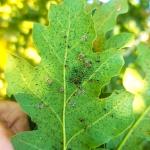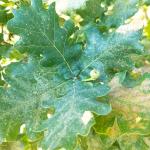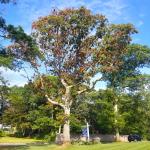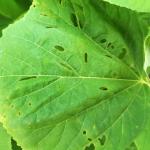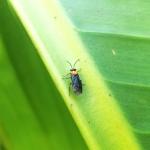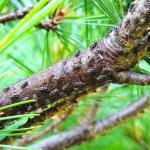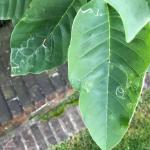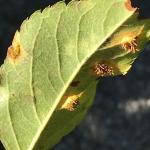UMass Extension's Landscape Message is an educational newsletter intended to inform and guide Massachusetts Green Industry professionals in the management of our collective landscape. Detailed reports from scouts and Extension specialists on growing conditions, pest activity, and cultural practices for the management of woody ornamentals, trees, and turf are regular features. The following issue has been updated to provide timely management information and the latest regional news and environmental data.
The Landscape Message will be updated twice in August. The next message will be posted on August 19. To receive immediate notification when the next Landscape Message update is posted, be sure to join our e-mail list
To read individual sections of the message, click on the section headings below to expand the content:
Scouting Information by Region
Environmental Data
The following data was collected on or about August 3, 2022. Total accumulated growing degree days (GDD) represent the heating units above a 50º F baseline temperature collected via regional NEWA stations (http://newa.cornell.edu) for the 2022 calendar year. This information is intended for use as a guide for monitoring the developmental stages of pests in your location and planning management strategies accordingly.
|
MA Region/Location |
GDD |
Soil Temp |
Precipitation |
Time/Date of Readings |
|||||
|
2-Week Gain |
2022 Total |
Sun |
Shade |
||||||
|
CAPE |
384 |
1595 |
76 |
72 |
0.04 |
12:00 PM 8/3 |
|||
|
SOUTHEAST |
375.5 |
1703 |
83 |
73 |
0.12 |
3:00 PM 8/3 |
|||
|
NORTH SHORE |
393 |
1655 |
74 |
69 |
0.12 |
10:00 AM 8/3 |
|||
|
EAST |
409 |
1866 |
85 |
77 |
0.07 |
5:00 PM 8/3 |
|||
|
METRO |
369 |
1723 |
72 |
68 |
0.26 |
6:00 AM 8/3 |
|||
|
CENTRAL |
379 |
1735 |
74 |
68 |
0.31 |
7:00 AM 8/3 |
|||
|
PIONEER VALLEY |
356.5 |
1731.5 |
76 |
70 |
1.74 |
12:00 PM 8/3 |
|||
|
BERKSHIRES |
300 |
1411 |
71 |
67 |
1.90 |
7:30 AM 8/3 |
|||
|
AVERAGE |
371 |
1678 |
76 |
70.5 |
0.57 |
_ |
|||
|
* = information not available |
|||||||||
Is your county in "Severe" or "Moderate" drought? Does your town have watering restrictions? Find out with these links: Massachusetts | U.S. Drought Monitor (unl.edu) and https://www.mass.gov/doc/water-use-restrictions-map/download
Phenology
| Indicator Plants - Stages of Flowering (BEGIN, BEGIN/FULL, FULL, FULL/END, END) | ||||||||
|---|---|---|---|---|---|---|---|---|
| PLANT NAME (Botanic / Common) | CAPE | S.E. | N.S. | EAST | METRO W. | CENT. | P.V. | BERK. |
|
Polygonum cuspidatum (Japanese knotweed) |
Begin |
Begin |
* |
* |
Begin |
Begin |
Begin |
* |
|
Clethra alnifolia (summersweet clethra) |
Full |
Begin/Full |
Begin |
Begin |
Begin |
Begin/Full |
Full |
Begin |
|
Hibiscus syriacus (rose-of-Sharon) |
Begin/Full |
Full/End |
Full/End |
Full |
Full/End |
Full/End |
Full/End |
Full |
|
Buddleia davidii (butterfly bush) |
Full |
Full/End |
Full/End |
Full/End |
Full/End |
Full/End |
Full/End |
Begin |
|
Campsis radicans (trumpet vine) |
Full/End |
Full/End |
Full/End |
Full/End |
Full/End |
Full/End |
Full/End |
Full |
|
Hydrangea paniculata (panicle hydrangea) |
Full |
Full |
Full |
Full |
Full/End |
Full |
Full |
Full |
|
Lythrum salicaria (purple loosestrife) |
Full/End |
Full/End |
Full/End |
Full/End |
Full/End |
Full/End |
Full/End |
Full |
| * = no activity to report/information not available | ||||||||
Regional Notes
Cape Cod Region (Barnstable)
General Conditions: The average temperature for the period from July 20 thru August 3 was 77°F with a high of 93°F on July 20 and a low of 59°F on July 31. The period has been dominated by days in the 80s with a couple of days reaching above 90°F and nights mostly in the 70s with a couple of nights in the 60s. A hot July and a hot start to August. Precipitation during the period amounted to a total of 0.04 inches occurring on August 1 & 2. The total precipitation for the month of July was 0.35”. Soil is very dry. Many water districts have mandatory water restrictions in place. Some herbaceous plants seen in bloom include daylily (Hemerocallis spp.), blazing star (Liatris spicata), purple coneflower (Echinacea purpurea), black eyed Susan (Rudbeckia hirta), balloon flower (Platycodon grandiflorus), garden phlox (Phlox paniculata), hardy hibiscus (Hibiscus mocheutos), plantain lily (Hosta spp.), and some early goldenrods beginning to bloom. Some woody plants seen in bloom include hydrangeas (Hydrangea spp.), crapemyrtle (Lagerstroemia indica), mimosa (Albizia julibrissin) and sourwood (Oxydendrum arboreum).
Pests/Problems: Drought conditions are impacting plant health. Most unirrigated lawns are crispy as are some irrigated lawns. The extended drought can result in permanent damage to lawns. The likelihood of recovery from summer dormancy continues to decrease as drought conditions continue. Hopefully moisture will arrive in the coming weeks to allow for fall repairs. Ornamental plants are also suffering; wilting, scorch, stress, premature leaf drop and death can be seen in unirrigated landscapes. Unestablished plants with inadequate supplemental watering are failing. Now is an important time to water woody plants to avoid lasting damage. Insect damage seen during the period includes pine tip moth damage on pitch pine and turpentine beetle damage on pitch pine. Turpentine beetle is very active for the time of year and stress from pine tip moth and drought are likely to lead to widespread attacks. Additional insecticide treatments may be needed to protect high value pitch pines. Other insects or insect damage seen during the period include hibiscus sawfly on hardy hibiscus, rose slug sawfly damage on rose (no larvae present), lacebug damage on andromeda and azalea, boxwood leafminer damage on boxwood, two spotted spider mite damage on numerous herbaceous plants, hemlock elongate scale on hemlock, white pine aphid on Japanese white pine, daylily leafminer damage on daylily, chilli thrips damage on hydrangea, eriophyid mites on linden and other woody species. Black oak gall wasp which has been rare recently was observed causing extensive damage to a single oak. Disease symptoms and signs seen during the period include volutella blight on boxwood, pear trellis rust on callery pear, black spot on rose, cedar apple rust on crabapple, guignardia blotch on horse chestnut, beech leaf disease on american beech, cercospora leaf spot on hydrangea and powdery mildew on just about any plant. Weeds seen in bloom include spotted knapweed (Centaurea stoebe), pokeweed (Phytolacca americana), lambsquarters (Chenopodium album), purslane (Portulaca oleracea), horseweed (Conyza canadensis), carpetweed (Mollugo verticillata) and spotted spurge (Euphorbia maculata). Rabbit numbers seem to be climbing.
Southeast Region (Dighton)
General Conditions: Oh my it's so dry that you don't need to be a weatherman to see we're having a drought. According to the NOAA drought map, released July 28th, we're in a severe drought. Local towns have imposed watering restrictions prohibiting irrigation and even washing cars. Lawns have progressed from stressed dormancy to burnt out straw. Maintenance crews are being laid off and grumpy landscapers are predicting an early fall season. It seems they may be right to judge by the piles of brown leaves that litter curbs of sidewalks and corners of yards. Drought threatens local wildlife as well with shallow ponds, swamp land and streams going dry. Day temperatures have ranged from highs of 97°F to lows of 81°F. Night temperatures have been between 73°F and 53°F. Passing showers have done almost nothing to relieve drought stress. With herbaceous plants wilting, pollinators have been markedly fewer in number over the past week but tiger swallowtail butterflies, hummingbird moths, and blue mud dauber wasps are active. In addition to the plants listed in the phenology chart above, some others in flower are: Asclepias incarnata (swamp milkweed), Daucus carota (queen Anne's lace), Eutrochium purpureum (sweet Joe pye weed), Hemerocallis spp. (daylily), Lilium tigrinum (tiger lily), Phlox paniculata (garden phlox), Oxydendrum arboreum (sorrel tree, sourwood), Rhus copallinum (winged sumac), Rosa spp. (rose), Rudbeckia hirta (black eyed Susan), Salvia yangii (Russian sage), Solidago juncea (early goldenrod, yellowtop), and Vitex agnus-castus (chaste tree).
Pests/Problems: Drought is killing shallow rooted plants and newer installations. Many folks have found themselves overwhelmed by watering duties and are losing plantings.
North Shore (Beverly)
General Conditions: Hot, dry and humid conditions persisted during this two week reporting period. There was a heat wave for several days at the beginning of the reporting period with temperatures above 90℉ recorded for five consecutive days. Heat advisories were issued for several days. The average daily temperature was 78℉, with the maximum temperature of 98℉ recorded on July 24 and the minimum temperature of 60℉ recorded on July 27. Very little precipitation was received - approximately 0.12 inches of rainfall were recorded at Long Hill during this period. Woody plants seen in bloom include: bottlebrush buckeye (Aesculus parviflora), the bee-bee tree or Korean evodia (Tetradium daniellii), sourwood (Oxydendrum arboreum), silk tree or mimosa (Albizia julibrissin), panicle hydrangea (Hydrangea paniculata), summersweet clethra (Clethra alnifolia), chaste tree (Vitex agnus-castus), harlequin glorybower (Clerodendrum trichotomum) and Chinese scholar tree (Styphnolobium japonicum). Herbaceous plants seen in bloom include: milkweed (Asclepias spp.), globe thistle (Echinops ritro), garden phlox (Phlox paniculata), coneflower (Echinacea purpurea), black-eyed Susan (Rudbeckia spp.), hostas (Hosta spp.), stonecrops (Sedum spp.), yarrow (Achillea millefolium), fairy candles (Actaea racemosa), yellow corydalis (Corydalis lutea), summer-flowering roses (Rosa spp.), New Zealand clematis vines (Clematis paniculata), American white water lily (Nymphaea odorata), Indian lotus (Nelumbo nucifera), and an assortment of annuals.
Pests/Problems: The region is in severe drought according to the US Drought Monitor. Grass on non-irrigated lawns exposed to full sun has turned brown due to drought stress. Some perennials on non-irrigated gardens are also showing drought stress. Powdery mildew continued to be observed on susceptible lilac varieties and on bee balm. Crabgrass, yellow nutsedge and other weeds are thriving. goldenrod (Solidago spp.) is in bloom on roadsides, helping pollinators. Its pollen is still mistakenly blamed for causing allergies when the real culprit is usually ragweed. Watch for poison ivy as you walk or work in the woods. Remember also that ticks and mosquitoes are still very active. Protect yourself with insect repellent when working outdoors especially at dawn and dusk.
East Region (Boston)
General Conditions: Hot and dry conditions persisted through July and continue into August. Daytime temperatures averaged 88℉, while overnight lows averaged 66℉. We received 0.07 inches of precipitation over the past 14 days. Perennial borders with supplemental irrigation are flowering and offering pollinator opportunities.
Pests/Problems: Extreme heat and lack of precipitation are major challenges throughout the landscape. Stressed plants are vulnerable to pest and disease outbreaks. Street trees are flagging and early leaf drop is common throughout the landscape. Drip irrigation, a common practice when establishing new landscapes, is proving to be insufficient under the recent conditions. Large, established tree roots are fighting for soil moisture while the root balls of recent transplants are hydrophobic.
Metro West (Acton)
General Conditions: The weather for the month of July can be described as dry, hot, and humid. For July, the monthly average precipitation is 3.95” and the total rainfall recorded for the month was 1.46”, making it the fifth consecutive month this year with below average precipitation recorded. There were 10 days in July with temperatures recorded in the 90s and we experienced our first heat wave of the season from July 19th to the 24th with high temperatures recorded at 92°, 95°, 97°, 94°, 97°, and 99° respectively. Observed in some stage of bloom this past week were the following plants: Albizia julibrissin (silk tree), Potentilla fruticosa (shrubby cinquefoil), Boltonia asteroides (Bolton’s aster), Daucus carota (Queen Anne's lace), Echinacea purpurea (coneflower), Eutrochium purpureum (Joe Pye weed), Hemerocallis spp. (daylily), Hosta spp. (plantain lily), Kirengeshoma palmata (yellow wax bells), Leucanthemum x superbum (shasta daisy), Lilium spp. (lily), Lysimachia clethroides (gooseneck loosestrife), Monarda didyma (scarlet beebalm), Patrinia gibbosa (patrinia), Perovskia atriplicifolia (Russian sage), Phlox carolina (Carolina phlox), P. paniculata (garden phlox), Physostegia virginiana (obedient plant), Platycodon grandiflorus (balloon flower), Rudbeckia fulgida var. sullivantii 'Goldsturm' (black eyed Susan), and Solidago spp. (goldenrod).
Pests/Problems: The continued lack of any substantial and steady rain continues to be a concern for our trees and shrubs in the landscape especially compounded with the hot and humid weather. As of July 28th, the Massachusetts Office of Energy and Environmental Affairs declared that 100% of the State was experiencing drought conditions. A Level D2 – "Severe Drought" has been declared for much of this area. (See map link above, under the Environmental Data table.) Impacts are many and some include outdoor water restrictions, brittle trees, trees susceptible to pests, and wildfire risks. Signs of plant stress are apparent in the landscape including premature leaf drop and flagging.
Central Region (Boylston)
General Conditions: This reporting period began with a 5-day streak of high temperatures well into the 90’s. Despite one day where the thermometer didn’t touch 80℉, this was by far the hottest stretch of the summer so far this year. Combined with the persistent lack of rainfall, the landscape is really showing the effects of drought. Unirrigated lawns are crispy, and even established trees and shrubs are in need of supplemental moisture at this time. Spotted Joe Pye weed (Eutrochium maculatum) has started blooming. Rudbeckia hirta (black-eyed Susan) looks great across the landscape in spite of the drought.
Pests/Problems: Powdery mildew has finally shown up in the garden and was spotted this reporting period on phlox, monarda, heliopsis, and peony. Drought concerns continue to expand. The US Drought Monitor has all of Massachusetts in some form of water deficit. The Central Region is in moderate to severe drought and likely moving toward extreme drought. (See map link above, under the Environmental Data table.) Wasps and hornets are active. Japanese beetle has been spotted on cannas and willows, among others. Late summer weeds have exploded in the heat, including crabgrass, purslane, and spurge.
Pioneer Valley Region (Amherst)
General Conditions: Late summer has arrived in the Pioneer Valley as the days get shorter and shade continues to creep further into the landscape. However, there’s still plenty of color on display from herbaceous perennials and annuals and despite the dry conditions, new growth continues on some trees and shrubs. For plants under regular irrigation, it’s been a good growing season so far. For plants without irrigation, local rainfall amounts, soil conditions and sun exposure are more critical factors determining health right now. July wound down with escalating heat index values from a brutal heat wave (7/25–28). After scattered showers on 7/24 & 7/25 that deposited 0.2–0.5” across Franklin County, a powerful band of thunderstorms rumbled through on 7/28. Accumulations were highest in southern Hampshire and Hampden Counties, with 1.07” (Chicopee) and 1.48” (Easthampton) recorded. Across the northern half of the valley, totals ranged from 0.26” (Ashfield), 0.38” (Deerfield), 0.40” (Belchertown) and 0.64” (Orange). This continued the recent trend of heavy rainfall in some parts of Hampshire and Hampden Counties, with 4.9” of rain recorded at the Easthampton gauge during the month of July. Additional scattered thunderstorms occurred on 8/1 and 8/2 with more scattered showers forecasted. Additional towns and cities have enacted water use restrictions according to Mass DEP, and the list now includes: Shelburne, Greenfield, Montague, Orange, Northampton, Hadley, Easthampton, Ware, West Springfield and Southwick. As the sun angle decreases, the intensity can feel stronger and deciduous plants may develop leaf reddening to avoid leaf burn.
Pests/Problems: A dry summer continues to be the major plant health issue for the tri-counties and the region remains in D1 (moderate drought) classification according to the U.S. Drought Monitor. With another round of heat and humidity in the forecast (at the time of writing), transpirational water loss will continue to stress trees and shrubs as they work to dissipate heat from the canopy. When water is transpired and evaporates from the surface of the foliage, it has a cooling effect that reduces surface leaf temperatures. It can account for more than 90% of daily water usage during periods of high heat. Trees and shrubs like crabapple, hawthorn, serviceberry, katsura and linden have been shedding older, brown leaves that appear dry and desiccated. A troubling trend has been observed throughout the southern valley involving Emerald Green (Thuja occidentalis ‘Smargd’) and Dark American arborvitae (T. occidentalis ‘Nigra’). Established trees are browning from the top of the canopy downward. In most cases, the dieback is severe, encompassing more than half of the total canopy. The symptoms began several weeks ago as a diffuse needle browning at the top of the canopy and has quickly spread downward. While anecdotal, at least a dozen mature hedges have been observed with this condition in Hampshire and Hampden Counties (along with Hartford County, CT). Oriental bittersweet seedlings are developing quickly right now and should be weeded immediately to avoid root establishment. 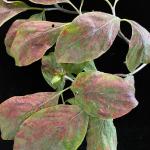 Powdery mildew diseases on oak, lilac and dogwood are becoming more visible due to the high humidity in recent weeks. The recent heat wave was good for crabgrass and after a slow start to the season, this ubiquitous lawn weed is lush and thick. Continue to scout for and report symptoms of beech leaf disease on American and European beech. The primary symptoms include dark interveinal banding and convex cupping. The disease continues to spread north and west in the Commonwealth, with two confirmed findings in Franklin County (Ashfield and Deerfield) and three in Hampshire County (Amherst, Goshen and Hatfield).
Powdery mildew diseases on oak, lilac and dogwood are becoming more visible due to the high humidity in recent weeks. The recent heat wave was good for crabgrass and after a slow start to the season, this ubiquitous lawn weed is lush and thick. Continue to scout for and report symptoms of beech leaf disease on American and European beech. The primary symptoms include dark interveinal banding and convex cupping. The disease continues to spread north and west in the Commonwealth, with two confirmed findings in Franklin County (Ashfield and Deerfield) and three in Hampshire County (Amherst, Goshen and Hatfield).
Berkshire Region (Great Barrington)
General Conditions: For the most part, the past two weeks has been hot with an occasional break from the heat. The highest temperatures at the three main recording stations in Berkshire County were: North Adams at 91℉ on July 20, 21, 23, and 24; Pittsfield at 89℉ on July 20, 23, and 24; Richmond at 90℉ on July 20, 21, 23, and 24. The average highs over the reporting period were 84.5℉ at both Richmond and North Adams, and 82.9℉ at Pittsfield. As of this reporting date (August 3) this hot trend is expected to continue with even higher temperatures being predicted. Fortunately, the County has escaped the worst of the drought in Massachusetts at this time and plant life seems to have been little affected. Just as soils approach drought conditions, there has been a brief but heavy downpour. Total rainfall at the four rainfall monitoring sites were 1.90 inches in West Stockbridge, 2.47 inches in North Adams, 1.14 inches in Pittsfield, and 1.25 inches in Richmond. As can be seen from that data, rainfall amounts can vary quite a bit, but that is to be expected given the long north to south dimension of the County. Though growth of turfgrass has slowed somewhat, it is still growing and this scout has not seen any signs of drought stressed lawns. Floral displays in plant beds and borders are abundant and colorful, again, showing no effect of drought. Interestingly, monarch butterflies have been plentiful not only in non-mowed meadows but also in home gardens. Yet, the International Union for Conservation of Nature recently listed monarch butterflies on their Red List as endangered. Hopefully, the increasing interest among the public and various conservation organizations in planting pollinator friendly gardens and meadows will be helpful in increasing the monarch population.
Pests/Problems: The optimism expressed in previous reports of an anticipated precipitous decline in the spongy moth (Lymantria dispar) population next year may have been a bit overstated. Reports are steadily coming in of large numbers of egg masses on the trunks of trees, particularly along the New York State border. However, at this site in West Stockbridge which was heavily infested this year and experienced considerable defoliation, the sightings of egg masses have been down quite a bit. Currently, plant pests observed are Japanese beetle, Oriental beetle, Asiatic garden beetle, aphids, and spider mites. A new pest sighting this week was the magnolia serpentine leafmining caterpillar (Phyllocnistis magnoliella). Slugs were found dining on the foliage of a variety of plants in shaded and heavily irrigated sites. Diseases observed included powdery mildew on a wide variety of plant species and sooty mold caused by aphid and mite feeding. The spore forming structures, called aecia, were observed on the underside of leaves on crabapples and apples infected by cedar apple rust. Another prominent disease is daylily yellow streak or daylily leaf streak.
Regional Scouting Credits
- CAPE COD REGION - Russell Norton, Horticulture and Agriculture Educator with Cape Cod Cooperative Extension, reporting from Barnstable.
- SOUTHEAST REGION - Brian McMahon, Arborist, reporting from the Dighton area.
- NORTH SHORE REGION - Geoffrey Njue, Green Industry Specialist, UMass Extension, reporting from the Long Hill Reservation, Beverly.
- EAST REGION - Kit Ganshaw & Sue Pfeiffer, Horticulturists reporting from the Boston area.
- METRO WEST REGION – Julie Coop, Forester, Massachusetts Department of Conservation & Recreation, reporting from Acton.
- CENTRAL REGION - Mark Richardson, Director of Horticulture reporting from New England Botanic Garden at Tower Hill, Boylston.
- PIONEER VALLEY REGION - Nick Brazee, Plant Pathologist, UMass Extension Plant Diagnostic Lab, reporting from Amherst.
- BERKSHIRE REGION - Ron Kujawski, Horticultural Consultant, reporting from Great Barrington.
Woody Ornamentals
Diseases
Recent pests and pathogens of interest seen in the UMass Extension Plant Diagnostic Lab, a select few:
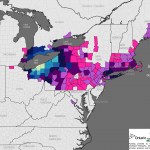 Beech leaf disease (BLD), caused by the foliar nematode Litylenchus crenatae ssp. mccannii continues its rapid spread throughout the northeastern U.S. and Canada. According to the most recent BLD distribution map (07/25/2022), the disease is now present in 11 states and the province of Ontario. To date, management options for infected trees remain extremely limited. The only treatment that has shown any possible efficacy is phosphites applied to the soil or as a trunk drench. As disease incidence increases in forest settings, the subsequent proliferation in inoculum will make it challenging to control the disease on landscape trees. A recent sample submitted to the lab came from a ~10-year-old weeping European beech (Fagus sylvatica ‘Pendula’) that was transplanted in early May. In recent weeks, a minor leaf wilt was observed and the submitted foliage had the distinctive symptoms of BLD (dark interveinal banding and convex cupping). New infestations occur in the fall, meaning this tree was already infected at the time of planting. While disease spread on nursery stock has been implicated in the movement of the pathogen, it does not represent the primary means of BLD dispersal. The primary vectors are still unknown, but birds and insects are likely the principal carriers of the nematode. According to the USFS Forest Inventory and Analysis program, there are over 140 million American beech trees (>1” dbh) in the forests of Massachusetts, representing 9.5% of all trees.
Beech leaf disease (BLD), caused by the foliar nematode Litylenchus crenatae ssp. mccannii continues its rapid spread throughout the northeastern U.S. and Canada. According to the most recent BLD distribution map (07/25/2022), the disease is now present in 11 states and the province of Ontario. To date, management options for infected trees remain extremely limited. The only treatment that has shown any possible efficacy is phosphites applied to the soil or as a trunk drench. As disease incidence increases in forest settings, the subsequent proliferation in inoculum will make it challenging to control the disease on landscape trees. A recent sample submitted to the lab came from a ~10-year-old weeping European beech (Fagus sylvatica ‘Pendula’) that was transplanted in early May. In recent weeks, a minor leaf wilt was observed and the submitted foliage had the distinctive symptoms of BLD (dark interveinal banding and convex cupping). New infestations occur in the fall, meaning this tree was already infected at the time of planting. While disease spread on nursery stock has been implicated in the movement of the pathogen, it does not represent the primary means of BLD dispersal. The primary vectors are still unknown, but birds and insects are likely the principal carriers of the nematode. According to the USFS Forest Inventory and Analysis program, there are over 140 million American beech trees (>1” dbh) in the forests of Massachusetts, representing 9.5% of all trees.- Phytophthora root rot of Siberian cypress (Microbiota decussata). A large landscape bed was planted with Microbiota in 2017, after the removal of shrub junipers that had deteriorated in aesthetic quality. The site is characterized by full sun in poorly-drained soils on a steep, south-facing slope. Large sections of the planting have experienced decline and death since installation and the mortality intensified in 2021. The record rainfall last season likely produced ideal conditions for root disease and spread of Phytophthora, which thrives in flooded soils. The submitted shrub was planted too deep and roots were growing from the lower portions of the main stem. The vascular tissue at the root flare was blackened and there was obvious decay of fine roots. Phytophthora was most likely established at the site for some time, resulting in decline of the junipers. Siberian cypress are known to have difficulty transplanting and the combined effects of Phytophthora root rot would be more than enough stress to cause mortality.
- Stem and branch cankering of rhododendron (Rhododendron sp.) and Blue Maid holly (Ilex × meserveae ‘Mesid’) caused by Botryosphaeria. Both plants are roughly eight to ten-years-old and were transplanted to the site three years ago with full sun and drip irrigation. Symptoms included yellowing/browning leaves, canopy thinning and scattered branch dieback. Winter injury may have predisposed the plants to infection, but a variety of stresses can facilitate infection by the ubiquitous Botryosphaeria.
- Brown needle spot, caused by Lecanosticta acicola, on Japanese black pine (Pinus thunbergii) and mugo pine (P. mugo). Both trees reside in an island landscape bed adjacent to a residential street. The site includes full sun and well-drained, loam soils and no supplemental irrigation. The Japanese black pine is approximately 30-years-old while the mugo pine is 15-years-old. Beginning in 2018, symptoms of needle blight have developed each year and include brown spotting scattered across the needle surface along with brown needle tips. Older needles are diseased and prematurely shedding while the current season’s needles appear asymptomatic. Lecanosticta has a broad host range among two-, three- and five-needle pines in forest and landscape settings.
- Dutch elm disease, caused by Ophiostoma novo-ulmi, of Siberian elm (Ulmus pumila). The tree is approximately 50-years-old and experiences full sun on an east-facing slope in an arboretum setting. Flagging of a canopy leader and epicormic suckers was observed in mid-July. The submitted sample had clear evidence of vascular staining and the pathogen was incubated from the symptomatic tissue. Japanese elm (U. davidiana var. japonica) and American elm (U. americana) from the site have also tested positive for DED this season.
Report by Nick Brazee, Plant Pathologist, UMass Extension Plant Diagnostic Lab, UMass Amherst.
Insects
An Update about Neonicotinoid Use in Massachusetts:
Beginning July 1, 2022 systemic insecticide active ingredients known as neonicotinoids have become state restricted use for tree and shrub uses in Massachusetts. If an individual works in the commercial industry (landscapers, arborists, etc.), then a Commercial Certification License is needed. (Example: Category 36 Commercial Certification License, Shade Trees & Ornamentals.) Someone can use a state or federal restricted use pesticide if they have a Commercial Applicators License as long as they are working under the direct supervision of someone with a Commercial Certification. Unlicensed or uncertified individuals will no longer be able to apply neonicotinoids to manage insect pests of trees and shrubs in Massachusetts.
More information is available, here: https://www.mass.gov/service-details/pesticide-newsupdates
Helpful Information from Taryn LaScola-Miner, Director, Crop and Pest Services Division of the MA Department of Agricultural Resources:
“As you know, products that contain neonicotinoids and have certain use patterns will have a classification change from General Use to Restricted Use on July 1, 2022. In order to help inform the manufacturers, dealers, sellers and applicators of which products will be changing from general use to restricted use, the Department has created the list of neonicotinoid products that currently are and will become restricted use beginning July 1st. You may find the list at the link below. Please note that this list is subject to change.
Additionally, MDAR is anticipating that there will be more of a need for companies to follow the Direct Supervision regulations with this change. Therefore, MDAR has updated its Direct Supervision Frequently Asked Questions document as well.
Although an email will be sent to all licensed applicators within the next few weeks as a final reminder of the change, please pass this information along to your members and customers as an effort to make this transition as smooth as possible. If you have any questions, please let me know. Thank you!”
List of Neonicotinoid Products: https://www.mass.gov/doc/list-of-neonicotinoid-pesticides/download
Direct Supervision Frequently Asked Questions: https://www.mass.gov/doc/direct-supervision-frequently-asked-questions-faq/download
Insects and Other Arthropods
-
Mosquitoes: The Massachusetts Department of Public Health (DPH) announced on 7/13/2022 that West Nile virus (WNV) had been detected in mosquitoes in Massachusetts for the first time in 2022. The presence of WNV was confirmed by the Massachusetts State Public Health Laboratory in a mosquito sample collected July 11 in the town of Easton, MA in Bristol County. More information about this detection is available here: https://www.mass.gov/news/state-public-health-officials-announce-seasons-first-west-nile-virus-positive-mosquito-sample-3
According to the Massachusetts Bureau of Infectious Disease and Laboratory Science and the Department of Public Health, there are at least 51 different species of mosquito found in Massachusetts. Mosquitoes belong to the Order Diptera (true flies) and the Family Culicidae (mosquitoes). As such, they undergo complete metamorphosis, and possess four major life stages: egg, larva, pupa, and adult. Adult mosquitoes are the only stage that flies and many female mosquitoes only live for 2 weeks (although the life cycle and timing will depend upon the species). Only female mosquitoes bite to take a blood meal, and this is so they can make eggs. Mosquitoes need water to lay their eggs in, so they are often found in wet or damp locations and around plants. Different species prefer different habitats. It is possible to be bitten by a mosquito at any time of the day, and again timing depends upon the species. Many are particularly active from just before dusk, through the night, and until dawn. Mosquito bites are not only itchy and annoying, but they can be associated with greater health risks. Certain mosquitoes vector pathogens that cause diseases such as West Nile virus (WNV) and eastern equine encephalitis (EEE). For local risk levels of WNV and EEE based on state sampling, visit: https://www.mass.gov/info-details/massachusetts-arbovirus-update.
For more information about mosquitoes in Massachusetts, visit: https://www.mass.gov/service-details/mosquitoes-in-massachusetts
There are ways to protect yourself against mosquitoes, including wearing long-sleeved shirts and long pants, keeping mosquitoes outside by using tight-fitting window and door screens, and using insect repellents as directed. Products containing the active ingredients DEET, permethrin, IR3535, picaridin, and oil of lemon eucalyptus provide protection against mosquitoes. Be aware that not all of these can be safely used on young children. Read and follow all label instructions for safety and proper use.
For more information about mosquito repellents, visit: https://www.mass.gov/service-details/mosquito-repellents and https://www.cdc.gov/mosquitoes/mosquito-bites/prevent-mosquito-bites.html .
-
Deer Tick/Blacklegged Tick: Ixodes scapularis adults are active all winter and spring, as they typically are from October through May, and “quest” or search for hosts at any point when daytime temperatures are above freezing. Engorged females survive the winter and will lay 1,500+ eggs in the forest leaf litter beginning around Memorial Day (late May). Larvae are encountered in New England from roughly May through November, with peak risk reported in August. Nymphs are encountered from April through July with a peak risk reported in June in New England. Nymphs may also be encountered again in October and November. For images of all deer tick life stages, along with an outline of the diseases they carry, visit: https://web.uri.edu/tickencounter/species/blacklegged-tick/ .
Anyone working in the yard and garden should be aware that there is the potential to encounter deer ticks. The deer tick or blacklegged tick can transmit Lyme disease, human babesiosis, human anaplasmosis, and other diseases. Preventative activities, such as daily tick checks, wearing appropriate clothing, and permethrin treatments for clothing (according to label instructions) can aid in reducing the risk that a tick will become attached to your body. If a tick cannot attach and feed, it will not transmit disease. For more information about personal protective measures, visit: https://web.uri.edu/tickencounter/prevention/protect-yourself/
The Center for Agriculture, Food, and the Environment provides a list of potential tick identification and testing resources here: https://ag.umass.edu/resources/tick-testing-resources .
-
Wasps/Hornets: Many wasps are predators of other arthropods, including pest insects such as certain caterpillars that feed on trees and shrubs. Adult wasps hunt prey and bring it back to their nest where young are being reared, as food for the immature wasps. A common such example are the paper wasps (Polistes spp.) who rear their young on chewed up insects. They may be seen searching plants for caterpillars and other soft-bodied larvae to feed their young. Paper wasps can sting, and will defend their nests, which are open-celled paper nests that are not covered with a papery “envelope”. These open-celled nests may be seen hanging from eaves or other outdoor building structures. Aerial yellow jackets and hornets create large aerial nests that are covered with a papery shell or “envelope”. Common yellow jacket species include those in the genus Vespula. Dolichovespula maculata is commonly known as the baldfaced hornet, although it is not a true hornet. The European hornet (Vespa crabro) is three times the size of a yellow jacket and may be confused for the northern* giant hornet (Vespa mandarinia). The European hornet is known to Massachusetts, but the northern giant hornet is not. If you are concerned that you have found or photographed a northern giant hornet, please report it here: https://massnrc.org/pests/report.aspx . A helpful ID tool, although developed for Texas by the USDA, depicts common look-a-like species that we also have in MA that can be confused for the northern giant hornet and is found here: https://agrilife.org/lubbock/files/2020/05/Asian_Giant_Hornet_Look-alikes_101_Xanthe_Shirley.pdf . Paper wasps and aerial yellowjackets overwinter as fertilized females (queens) and a single female produces a new nest annually in the late spring. Queens start new nests, lay eggs, and rear new wasps to assist in colony/nest development. Nests are abandoned at the end of the season. Some people are allergic to stinging insects, so care should be taken around wasp/hornet nests. Unlike the European honeybee (Apis mellifera), wasps and hornets do not have barbed stingers, and therefore can sting repeatedly when defending their nests. It is best to avoid them, and if that cannot be done and assistance is needed to remove them, consult a professional.
*For more information about the recent common name change for Vespa mandarinia, please visit: https://entsoc.org/news/press-releases/northern-giant-hornet-common-name-vespa-mandarinia
Woody ornamental insect and non-insect arthropod pests to consider, a selected few:
Invasive Insects & Other Organisms Update:
-

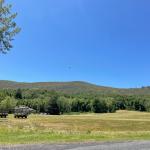
 Spongy Moth: Lymantria dispar activity in parts of Berkshire County has been heightened this year. Many areas have experienced defoliation and large numbers of caterpillars. The good news is, spongy moth caterpillar activity for 2022 is coming to an end.
Spongy Moth: Lymantria dispar activity in parts of Berkshire County has been heightened this year. Many areas have experienced defoliation and large numbers of caterpillars. The good news is, spongy moth caterpillar activity for 2022 is coming to an end.
More good news: activity from the NPV virus and the spongy moth caterpillar killing fungus, Entomophaga maimaiga, has been reported in Berkshire County! Fungus and virus killed caterpillars have been 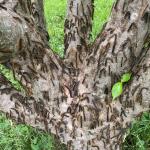

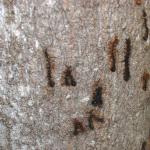 reported in Williamstown, MA (6/21/2022) and Sheffield, MA (6/16/2022). Fungus-killed caterpillars will appear shriveled and dried, typically hanging vertically in a straight line on the trunks and branches of their hosts, or other surfaces nearby. Virus killed caterpillars tend to droop in an inverted-V shape and are often moist/juicy in appearance. The fungus and virus will hopefully help reduce the population of spongy moths in Berkshire County for next year – although time will tell.
reported in Williamstown, MA (6/21/2022) and Sheffield, MA (6/16/2022). Fungus-killed caterpillars will appear shriveled and dried, typically hanging vertically in a straight line on the trunks and branches of their hosts, or other surfaces nearby. Virus killed caterpillars tend to droop in an inverted-V shape and are often moist/juicy in appearance. The fungus and virus will hopefully help reduce the population of spongy moths in Berkshire County for next year – although time will tell.
The bottom line: do not panic. The spongy moth (Lymantria dispar) has been in Massachusetts since the 1860’s and periodic outbreaks have occurred since then. Due to the fungus, virus, and other natural enemies, the populations will crash again. There are no chemical management strategies applicable for spongy moth at this time in its life cycle. Scout for overwintering egg masses this fall and winter to plan if management might be applicable in Berkshire County next spring.
Why did the common name for Lymantria dispar change recently? More information is available here: https://entsoc.org/news/press-releases/spongy-moth-approved-new-common-name-lymantria-dispar
To learn more about the life cycle and natural enemies of this insect, including the NPV virus and Entomophaga maimaiga,
visit: https://ag.umass.edu/landscape/education-events/insectxaminer.
-
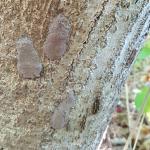 Spotted Lanternfly: (Lycorma delicatula, SLF) is a non-native, invasive insect that feeds on over 103 species of plants, including many trees and shrubs that are important in our landscapes.
Spotted Lanternfly: (Lycorma delicatula, SLF) is a non-native, invasive insect that feeds on over 103 species of plants, including many trees and shrubs that are important in our landscapes.
Currently, the only established populations of spotted lanternfly in Massachusetts are in a small area in both Fitchburg and Shrewsbury, MA. Therefore, there is no reason to be preemptively treating for this insect in other areas of Massachusetts. If you suspect you have found spotted lanternfly in additional locations, please report it immediately to MDAR here: https://massnrc.org/pests/slfreport.aspx . If you are living and working in the Fitchburg and Shrewsbury areas, please be vigilant and continue to report anything suspicious.
For More Information:
From UMass Extension:
Check out the InsectXaminer Episode about spotted lanternfly adults and egg masses! Available here: https://ag.umass.edu/landscape/education-events/insectxaminer
Fact Sheet: https://ag.umass.edu/landscape/fact-sheets/spotted-lanternfly
From the MA Department of Agricultural Resources:
Fact Sheet and Map of Locations in MA: https://massnrc.org/pests/pestFAQsheets/spottedlanternfly.html
-
Asian Longhorned Beetle: (Anoplophora glabripennis, ALB) Look for signs of an ALB infestation which include perfectly round exit holes (about the size of a dime), shallow oval or round scars in the bark where a female has chewed an egg site, or sawdust-like frass (excrement) on the ground nearby host trees or caught in between branches. Be advised that other, native insects may create perfectly round exit holes or sawdust-like frass, which can be confused with signs of ALB activity.
The regulated area for Asian longhorned beetle is 110 square miles encompassing Worcester, Shrewsbury, Boylston, West Boylston, and parts of Holden and Auburn. If you believe you have seen damage caused by this insect, such as exit holes or egg sites, on susceptible host trees like maple, please call the Asian Longhorned Beetle Eradication Program office in Worcester, MA at 508-852-8090 or toll free at 1-866-702-9938.
To report an Asian longhorned beetle find online or compare it to common insect look-alikes, visit: http://massnrc.org/pests/albreport.aspx or https://www.aphis.usda.gov/pests-diseases/alb/report .
-
Browntail Moth: Euproctis chrysorrhoea is an invasive insect originating from Europe and first detected in the US in Somerville, MA in 1897. Currently, browntail moth is limited to a small portion of eastern Massachusetts, particularly areas near the coast. Report suspected browntail moth life stages here: https://massnrc.org/pests/pestreports.htm . Due to a persistent outbreak of this insect in Maine since approximately 2016, it is a good idea for us to again familiarize ourselves with this pest. (For more information and the latest updates about the status of this insect in Maine, visit: https://www.maine.gov/dacf/mfs/forest_health/invasive_threats/browntail_moth_info.htm .)
Caution: hairs found on the caterpillar and pupal life stages of this insect can cause a rash similar to poison ivy. Some individuals are very sensitive to browntail moth hairs and may also experience allergic reaction. The chance of interacting with browntail moth hairs increases between May and July, although they could be a problem at any time of year.
The larval or caterpillar stage of this insect is present from August until the following June (spending the winter in webs they create on the tips of host plant twigs). In the fall, groups of caterpillars are found creating webs around a tightly wrapped leaf (covered in bright white silk) where they will overwinter in groups of 25-400. These 2-4 inch long webs can be found on the ends of branches often on apple or red oak. As soon as leaves begin to open in the spring (usually by April), the caterpillars will crawl from their webs to feed on the new leaves. Caterpillars are fully grown around June and spin cocoons in which they pupate. These cocoons are also full of the irritating hairs and should be dealt with extreme caution. Adult moths emerge in July and females lay eggs on the undersides of leaves in masses of 200-400, covering them with hairs from their bodies. (Adults do not typically cause skin rashes.) Eggs hatch around August and September and larvae feed shortly before forming their overwintering webs.
The primary concern with this insect are the poisonous hairs found on the caterpillars. Contact with the caterpillar or its hairs can cause a rash similar to poison ivy in susceptible individuals. If hairs break off and blow around in the wind, they can cause difficulty breathing and headaches. While this insect can act as a defoliator in the larval stage, feeding on the leaves of many deciduous trees and shrubs, this activity may be secondary to concerns about public health risks. Care should be taken to avoid places infested with these caterpillars, exposed skin or clothing should be washed, and the appropriate PPE should be worn if working with these insects. Consult your physician if you have a reaction to the browntail moth.
-
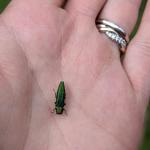 Emerald Ash Borer: (Agrilus planipennis, EAB) has been detected in at least 11 out of the 14 counties in Massachusetts. A map of these locations across the state may be found here: https://ag.umass.edu/fact-sheets/emerald-ash-borer . Additional information about this insect is provided by the MA Department of Conservation and Recreation, here:https://arcg.is/j8TiD .
Emerald Ash Borer: (Agrilus planipennis, EAB) has been detected in at least 11 out of the 14 counties in Massachusetts. A map of these locations across the state may be found here: https://ag.umass.edu/fact-sheets/emerald-ash-borer . Additional information about this insect is provided by the MA Department of Conservation and Recreation, here:https://arcg.is/j8TiD .
This wood-boring beetle readily attacks ash (Fraxinus spp.) including white, green, and black ash and has also been found developing in white fringe tree (Chionanthus virginicus) and has been reported in cultivated olive (Olea europaea). Signs of an EAB infested tree may include D-shaped exit holes in the bark (from adult emergence), “blonding” or lighter coloration of the ash bark from woodpecker feeding (chipping away of the bark as they search for larvae beneath), and serpentine galleries visible through splits in the bark, from larval feeding beneath. It is interesting to note that woodpeckers are capable of eating 30-95% of the emerald ash borer larvae found in a single tree (Murphy et al. 2018). Unfortunately, despite high predation rates, EAB populations continue to grow. However, there is hope that biological control efforts will eventually catch up with the emerald ash borer population and preserve some of our native ash tree species for the future. For an update about the progress of the biological control of emerald ash borer, visit Dr. Joseph Elkinton’s archived 2022 webinar.
-
Jumping Worms: Amynthas spp. earthworms, collectively referred to as “jumping or crazy or snake” worms, overwinter as eggs in tiny, mustard-seed sized cocoons found in the soil or other substrate (ex. compost) that are impossible to remove. The first adults appear in the end of May – June, but the numbers are low and infestations are rarely noticed at that time. It is easy to misidentify earthworms if only immatures found. By August and September, this is when most observations of fully mature jumping worms occur. At that time, snake worms become quite abundant, infestations become very noticeable, and may cause a lot of concern for property owners and managers.
For More Information:
UMass Extension Fact Sheets:
*NEW* Resource with Over 70 Questions and their Answers: Invasive Jumping Worm Frequently Asked Questions:
https://ag.umass.edu/landscape/fact-sheets/invasive-jumping-worm-frequently-asked-questions
Earthworms in Massachusetts – History, Concerns, and Benefits: https://ag.umass.edu/landscape/fact-sheets/earthworms-in-massachusetts-history-concerns-benefits
Jumping/Crazy/Snake Worms – Amynthas spp.:
https://ag.umass.edu/landscape/fact-sheets/jumpingcrazysnake-worms-amynthas-spp
A Summary of the Information Shared at UMass Extension’s Jumping Worm Conference in January 2022:
https://ag.umass.edu/news-events/highlights/jumping-worms-conference
Tree & Shrub Insect Pests, Continued:
- Asiatic Garden Beetle: Maladera castanea adults are active and are typically most abundant in July and August. These rusty-red colored beetles are bullet-shaped and active at night. They are often attracted to porch lights. They feed on a number of ornamental plants, defoliating leaves by giving the edges a ragged appearance and also feeding on blossoms. Butterfly bush, rose, dahlia, aster, and chrysanthemum can be favored hosts.
- Azalea Sawflies: There are a few species of sawflies that impact azaleas. Johnson and Lyon's Insects that Feed on Trees and Shrubs mentions three of them. Amauronematus azaleae was first reported in New Hampshire in 1895 and is likely found in most of New England. Adults of this species are black with some white markings and wasp-like. Generally green larvae feed mostly on mollis hybrid azaleas. Remember, sawfly caterpillars have at least enough abdominal prolegs to spell “sawfly” (so 6 or more prolegs). Adults are present in May, and females lay their eggs and then larvae hatch and feed through the end of June. There is one generation per year. Nematus lipovskyi has been reared from swamp azalea (Rhododendron viscosum). Adults of that species have been collected in April (in states to the south) and May (in New England) and larval feeding is predominantly in late April and May in Virginia and June in New England. One generation of this species occurs per year, and most mollis hybrid azaleas can be impacted. A third species, Arge clavicornis, is found as an adult in July and lays its eggs in leaf edges in rows. Larvae are present in August and September. Remember, Bacillus thuringiensis Kurstaki does not manage sawflies.
-
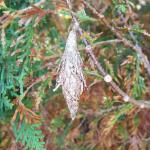 Bagworm: Thyridopteryx ephemeraeformis is a native species of moth whose larvae construct bag-like coverings over themselves with host plant leaves and twigs. Look for caterpillars with cone-like coverings of chewed up leaves, bark, and other plant parts. Common bagworm may be found on evergreen and deciduous host plants. More information can be found here: https://ag.umass.edu/landscape/fact-sheets/bagworm .
Bagworm: Thyridopteryx ephemeraeformis is a native species of moth whose larvae construct bag-like coverings over themselves with host plant leaves and twigs. Look for caterpillars with cone-like coverings of chewed up leaves, bark, and other plant parts. Common bagworm may be found on evergreen and deciduous host plants. More information can be found here: https://ag.umass.edu/landscape/fact-sheets/bagworm .
- Dogwood Sawfly: Macremphytus tarsatus has one generation per year. The larvae of the dogwood sawfly overwinter in decaying wood and occasionally compromised structural timber. An overwintering "cell" is created in this soft wood. Pupation occurs in the springtime and adults can take a lengthy time to emerge, roughly between late May and July. 100+ eggs are laid in groups on the underside of leaves. Eggs hatch and the larvae feed gregariously, initially skeletonizing leaves. As the caterpillars grow in size, they are capable of eating the entire leaf with the exception of the midvein. Larval appearance varies greatly throughout instars, so much so that one might mistake them for multiple species. Early instars are translucent and yellow, but as the caterpillars grow they develop black spots (over yellow) and become covered in a white powder-like material. Larvae and their shed skins may resemble bird droppings. Full grown larvae begin to wander in search of a suitable overwintering location. Rotting wood lying on the ground is preferred for this. Wandering dogwood sawflies have been reported from Franklin, MA as of 7/20/2022 as this insect prepares for the winter by finding rotting wood to burrow within. Foliage of dogwood, especially gray dogwood (Cornus racemosa) may be impacted. Skeletonizes leaves at first, then eats all but the midvein.
- Fall Home-Invading Insects: Various insects, such as ladybugs, boxelder bugs, seedbugs, and stink bugs will begin to seek overwintering shelters in warm places, such as homes, throughout the next couple of months. While such invaders do not cause any measurable structural damage, they can become a nuisance especially when they are present in large numbers. While the invasion has not yet begun, if you are not willing to share your home with such insects, now should be the time to repair torn window screens, repair gaps around windows and doors, and shore up any other gaps through which they might enter the home.
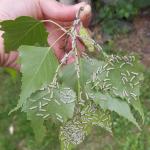 Fall Webworm: Hyphantria cunea is native to North America and Mexico. It is now considered a world-wide pest, as it has spread throughout much of Europe and Asia. (For example, it was introduced accidentally into Hungary from North America in the 1940’s.) Hosts include nearly all shade, fruit, and ornamental trees except conifers. In the USA, at least 88 species of trees are hosts for these insects, while in Europe at least 230 species are impacted. In the past history of this pest, it was once thought that the fall webworm was a two-species complex. It is now thought that H. cunea has two color morphs – one black headed and one red headed. These two color forms differ not only in the coloration of the caterpillars and the adults, but also in their behaviors. Caterpillars may go through at least 11 molts, each stage occurring within a silken web they produce over the host. When alarmed, all caterpillars in the group will move in unison in jerking motions that may be a mechanism for self-defense. Depending upon the location and climate, 1-4 generations of fall webworm can occur per year. Fall webworm adult moths lay eggs on the underside of the leaves of host plants in the spring. These eggs hatch in late June or early July depending on climate. Young larvae feed together in groups on the undersides of leaves, first skeletonizing the leaf and then enveloping other leaves and eventually entire branches within their webs. Tiny, early instar (black-headed) fall webworm caterpillars were observed feeding on birch in Hampshire County, MA on 7/5/2022. At this size, caterpillars skeletonize the leaves as they feed. Webs are typically found on the terminal ends of branches. All caterpillar activity occurs within this tent, which becomes filled with leaf fragments, cast skins, and frass. Fully grown larvae then wander from the webs and pupate in protected areas such as the leaf litter where they will remain for the winter. Adult fall webworm moths emerge the following spring/early summer to start the cycle over again. 50+ species of parasites and 36+ species of predators are known to attack fall webworm in North America. Fall webworms typically do not cause extensive damage to their hosts. Nests may be an aesthetic issue for some. If in reach, small fall webworm webs may be pruned out of trees and shrubs and destroyed. Do not set fire to H. cunea webs when they are still attached to the host plant.
Fall Webworm: Hyphantria cunea is native to North America and Mexico. It is now considered a world-wide pest, as it has spread throughout much of Europe and Asia. (For example, it was introduced accidentally into Hungary from North America in the 1940’s.) Hosts include nearly all shade, fruit, and ornamental trees except conifers. In the USA, at least 88 species of trees are hosts for these insects, while in Europe at least 230 species are impacted. In the past history of this pest, it was once thought that the fall webworm was a two-species complex. It is now thought that H. cunea has two color morphs – one black headed and one red headed. These two color forms differ not only in the coloration of the caterpillars and the adults, but also in their behaviors. Caterpillars may go through at least 11 molts, each stage occurring within a silken web they produce over the host. When alarmed, all caterpillars in the group will move in unison in jerking motions that may be a mechanism for self-defense. Depending upon the location and climate, 1-4 generations of fall webworm can occur per year. Fall webworm adult moths lay eggs on the underside of the leaves of host plants in the spring. These eggs hatch in late June or early July depending on climate. Young larvae feed together in groups on the undersides of leaves, first skeletonizing the leaf and then enveloping other leaves and eventually entire branches within their webs. Tiny, early instar (black-headed) fall webworm caterpillars were observed feeding on birch in Hampshire County, MA on 7/5/2022. At this size, caterpillars skeletonize the leaves as they feed. Webs are typically found on the terminal ends of branches. All caterpillar activity occurs within this tent, which becomes filled with leaf fragments, cast skins, and frass. Fully grown larvae then wander from the webs and pupate in protected areas such as the leaf litter where they will remain for the winter. Adult fall webworm moths emerge the following spring/early summer to start the cycle over again. 50+ species of parasites and 36+ species of predators are known to attack fall webworm in North America. Fall webworms typically do not cause extensive damage to their hosts. Nests may be an aesthetic issue for some. If in reach, small fall webworm webs may be pruned out of trees and shrubs and destroyed. Do not set fire to H. cunea webs when they are still attached to the host plant.-
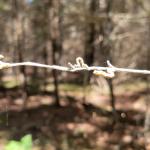
 Hemlock Looper: As mentioned previously this season, two species of geometrid moths in the genus Lambdina are native insects capable of defoliating eastern hemlock, balsam fir, and white spruce. Adult moths lay their eggs on the trunk and limbs of hosts in September and October, and eggs will hatch by late May or early June. (L. fiscellaria caterpillars may be active between 448-707 GDD’s.) Monitor susceptible hosts for small, inch-worm-like caterpillars.
Hemlock Looper: As mentioned previously this season, two species of geometrid moths in the genus Lambdina are native insects capable of defoliating eastern hemlock, balsam fir, and white spruce. Adult moths lay their eggs on the trunk and limbs of hosts in September and October, and eggs will hatch by late May or early June. (L. fiscellaria caterpillars may be active between 448-707 GDD’s.) Monitor susceptible hosts for small, inch-worm-like caterpillars.The Massachusetts Department of Conservation and Recreation recently reported increased hemlock looper caterpillar activity in parts of Templeton, Warwick, and Northfield, MA as of 7/13/2022. (See photos.) At this time of year, any damage caused by these caterpillars on hemlock cannot be reversed and their activity is near its end for the season. Anyone with trees impacted in those areas should monitor remaining healthy hosts for potential activity in 2023.
Where populations are low, no management is necessary. Hemlock loopers have several effective natural enemies.
-
Hemlock Woolly Adelgid: Adelges tsugae is present on eastern and Carolina hemlock. The overwintering hemlock woolly adelgid generation (sistens) is present through mid-spring and produces the spring generation (progrediens) which will be present from early spring through mid-summer. HWA, unlike many other insects, does most of its feeding over the winter. Eggs may be found in wooly masses at the base of hemlock needles beginning in mid-March. Each wooly mass is created by a female who may then lay 50-300 eggs. Eggs hatch and crawlers may be found from mid-March through mid-July. Infested trees may be treated with foliar sprays in late April to early May, using Japanese quince as a phenological indicator. Systemic* applications may be made in the spring and fall, or when soil conditions are favorable for translocation to foliage. Nitrogen fertilizer applications may make hemlock woolly adelgid infestations worse.
*UMass Extension has recently received questions about systemic active ingredient options that may be used to manage hemlock woolly adelgid as an alternative to neonicotinoid insecticides. A couple of options include but are not limited to: abamectin (avermectin/milbemycin), acephate (organophosphate), and azadirachtin (unknown/uncertain mode of action). General use products are available, and each of these active ingredients are labeled for use on trees and/or shrubs. Many products are labeled for use against hemlock woolly adelgid or adelgids.
Of these active ingredients, azadirachtin is considered to be reduced risk. It is generally considered a safe option for honeybees and other beneficial insects, however some products state that azadirachtin is toxic to fish and other aquatic invertebrates (and as such, the products come with special instructions for precautions when using them near water).
Unlike the neonicotinoids (dinotefuran and imidacloprid, primarily), these systemic active ingredient alternatives do not have efficacy data for the management of hemlock woolly adelgid readily available in the scientific literature. Further research concerning abamectin, acephate, and azadiractin (as well as chlorantraniliprole, a ryanodine receptor modulator/diamide/anthranilic diamide) and their efficacy against hemlock woolly adelgid is needed (McCarty and Addesso, 2019).
-
Hickory Tussock Moth: Lophocampa caryae is native to southern Canada and the northeastern United States. There is one generation per year. Overwintering occurs as a pupa inside a fuzzy, oval shaped cocoon. Adult moths emerge approximately in May and their presence can continue into July. Females will lay clusters of 100+ eggs together on the underside of leaves. Females of this species can fly, however they have been called weak fliers due to their large size. When first hatched from their eggs, the young caterpillars will feed gregariously in a group, eventually dispersing and heading out on their own to forage. Caterpillar maturity can take up to three months and color changes occur during this time. These caterpillars are essentially white with some black markings and a black head capsule. They are very hairy, and should not be handled with bare hands as many people can have skin irritation or rashes (dermatitis) as a result of interacting with hickory tussock moth hairs. By late September, the caterpillars will create their oval, fuzzy cocoons hidden in the leaf litter where they will again overwinter. Hosts whose leaves are fed upon by these caterpillars include but are not limited to hickory, walnut, butternut, linden, apple, basswood, birch, elm, black locust, and aspen. Maple and oak have also been reportedly fed upon by this insect. Several wasp species are parasitoids of hickory tussock moth caterpillars.
 Imported Willow Leaf Beetle: Plagiodera versicolora adult beetles overwinter near susceptible hosts. Adult beetles will chew holes and notches in the leaves of willow once they become available. Females lay yellow eggs in clusters on the undersides of leaves. Larvae are slug-like and bluish-green in color. They will feed in clusters and skeletonize the leaves. Most plants can tolerate multiple years of feeding from this insect, and foliage will appear brown. Repeated yearly feeding can occasionally be an issue, in which case management of the young larvae may be necessary. Take care with treatment in areas near water. Check out Episode 4 of InsectXaminer to see the imported willow leaf beetle in action: https://ag.umass.edu/landscape/education-events/insectxaminer
Imported Willow Leaf Beetle: Plagiodera versicolora adult beetles overwinter near susceptible hosts. Adult beetles will chew holes and notches in the leaves of willow once they become available. Females lay yellow eggs in clusters on the undersides of leaves. Larvae are slug-like and bluish-green in color. They will feed in clusters and skeletonize the leaves. Most plants can tolerate multiple years of feeding from this insect, and foliage will appear brown. Repeated yearly feeding can occasionally be an issue, in which case management of the young larvae may be necessary. Take care with treatment in areas near water. Check out Episode 4 of InsectXaminer to see the imported willow leaf beetle in action: https://ag.umass.edu/landscape/education-events/insectxaminer
- Japanese Beetles: Popillia japonica adult beetles are active. Adult female beetles will lay their eggs primarily by early August, however eggs may be laid into September. Females lay these eggs in groups in soil cavities they excavate 2-4 inches down. Japanese beetles overwinter as nearly grown grubs in the soil which are capable of evading freezing behaviorally by moving below the frost line. As soils warm in the spring, larvae become active and feed on the roots of grasses. Pupation occurs 1-3 feet below the soil surface. Adults emerge from these lawn areas and disperse to feed on foliage, mate, and return to turf-type locations for females to lay their eggs. Japanese beetle adults use aggregation pheromones (chemicals that signal between individuals) to call in others of the same species. These pheromones and volatile chemicals from host plants being fed upon are thought to be the reason why large numbers of these beetles can be found feeding together. Adult beetles feed on foliage and flowers, often skeletonizing leaves until they appear lace-like. Larvae are highly damaging turf pests. Tree and shrub hosts are comprised of more than 300 species including but not limited to rose, mountain-ash, willow, linden, elm, Japanese and Norway maples, birch, sycamore, rose of Sharon, ornamental apple, and many others. Adult beetles are often attracted to feeding on sunny areas of the plant. Many organisms are parasitoids of Japanese beetles, such as two wasps that attack overwintered grubs in the spring, and a tachinid fly (winsome fly: Istocheta aldrichi) which parasitizes newly emerged adult beetles. Other organisms act as generalist predators with Japanese beetles on their menus, including but not limited to ants, certain other beetles, small mammals, and birds.
- Lacebugs: Stephanitis spp. lacebugs such as S. pyriodes can cause severe injury to azalea foliage. S. rhododendri can be common on rhododendron and mountain laurel. S. takeyai has been found developing on Japanese andromeda, leucothoe, styrax, and willow. Stephanitis spp. lace bug activity should be monitored through September. Before populations become too large, treat with a summer rate horticultural oil spray as needed. Be sure to target the undersides of the foliage in order to get proper coverage of the insects. Certain azalea and andromeda cultivars may be less preferred by lace bugs.
-
Magnolia Scale: Neolecanium cornuparvum is distributed throughout the eastern United States. Host plants include: Magnolia stellata (star Magnolia), M. acuminata (cucumber Magnolia), M. liliiflora ‘Nigra’ (lily Magnolia; formerly M. quinquepeta), and M. soulangeana (Chinese Magnolia). Other species may be hosts for this scale, but are attacked to a lesser degree. M. grandiflora (southern Magnolia) may be such an example.
Mature individuals settle on a location on branches and twigs, then insert piercing-sucking mouthparts to feed. The insects feed on plant fluids and excrete large amounts of a sugary substance known as honeydew. Sooty mold, often black in color, will then grow on the honeydew that has coated branches and leaves. Repeated, heavy infestations can result in branch dieback and at times, death of the plant. Honeydew may also be very attractive to ants, wasps, and hornets. The magnolia scale overwinters as a young nymph (immature stage) which is elliptical in shape, mostly a dark-slate gray, except for a median ridge that is red/brown in color. These overwintering nymphs may be found on the undersides of 1st and 2nd year old twigs. The first molt (shedding of the exoskeleton to allow growth) can occur by late April or May in parts of this insect’s range and the second molt will occur in early June. At that time, the immature scales have turned a deep purple color. Stems of the host plant may appear purple in color and thickened – but this is a coating of nymphal magnolia scales, not the stem itself. Eventually, these immature scales secrete a white layer of wax over their bodies, looking as if they have been rolled in powdered sugar. By August, the adult female scale is fully developed, elliptical and convex in shape and ranging from a pinkish-orange to a dark brown color. Adult females may also be covered in a white, waxy coating. By that time, the females produce nymphs (living young; eggs are not “laid”) that wander the host before settling on the newest twigs to overwinter. In the Northeastern United States, this scale insect has a single generation per year.
-
Tuliptree Aphid: Illinoia liriodendri is a species of aphid associated with the tuliptree, wherever it is grown. Depending upon local temperatures, these aphids may be present from mid-June through early fall. Large populations can develop by late summer. Some leaves, especially those in the outer canopy, may turn brown or yellow and drop from infested trees prematurely. The most significant impact these aphids can have is typically the resulting honeydew, or sugary excrement, which may be present in excessive amounts and coat leaves and branches, leading to sooty mold growth. This honeydew may also make a mess of anything beneath the tree. Wingless adults are approximately 1/8 inch in length, oval, and can range in color from pale green to yellow. There are several generations per year. This is a native insect. Management is typically not necessary, as this insect does not significantly impact the overall health of its host. Tuliptree aphids also have plenty of natural enemies, such as ladybeetles and parasites.
- Two-Spotted Spider Mite: Tetranychus urticae is a “warm-season” mite that loves hot and dry weather, which may favor the quick reproduction and build-up of this pest. Management should seek to preserve beneficial predatory mites. Monitor susceptible hosts (elm, maple, redbud, ash, black locust, tuliptree, and many deciduous shrubs) for increasing numbers of these mites until mid-August. Mites will be found on the undersides of leaves and cause stippling of the foliage.
-
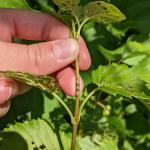 Viburnum Leaf Beetle: Pyrrhalta viburni is a beetle in the family Chrysomelidae that is native to Europe, but was found in Massachusetts in 2004. This beetle feeds exclusively on many different species of viburnum, which includes, but is not limited to, susceptible plants such as V. dentatum, V. nudum, V. opulus, V. propinquum, and V. rafinesquianum. Adult beetles emerge following pupation in early July. At this time, adult beetles will resume feeding, mate, and the females will lay their eggs in pits they chew at the ends of twigs. Eggs overwinter. Adults may also migrate to previously not yet infested plants. Adult viburnum leaf beetle feeding appears different from that of the larvae. Adults chew oblong holes in leaves. Some viburnum have been observed to have varying levels of resistance to this insect, including but not limited to V. bodnantense, V. carlesii, V. davidii, V. plicatum, V. rhytidophyllum, V. setigerum, and V. sieboldii. More information about viburnum leaf beetle may be found at http://www.hort.cornell.edu/vlb/ .
Viburnum Leaf Beetle: Pyrrhalta viburni is a beetle in the family Chrysomelidae that is native to Europe, but was found in Massachusetts in 2004. This beetle feeds exclusively on many different species of viburnum, which includes, but is not limited to, susceptible plants such as V. dentatum, V. nudum, V. opulus, V. propinquum, and V. rafinesquianum. Adult beetles emerge following pupation in early July. At this time, adult beetles will resume feeding, mate, and the females will lay their eggs in pits they chew at the ends of twigs. Eggs overwinter. Adults may also migrate to previously not yet infested plants. Adult viburnum leaf beetle feeding appears different from that of the larvae. Adults chew oblong holes in leaves. Some viburnum have been observed to have varying levels of resistance to this insect, including but not limited to V. bodnantense, V. carlesii, V. davidii, V. plicatum, V. rhytidophyllum, V. setigerum, and V. sieboldii. More information about viburnum leaf beetle may be found at http://www.hort.cornell.edu/vlb/ . -

 White Satin Moth: Leucoma salicis has again been reported from Beartown State Forest (Berkshire County) on 6/8/2022 by the Massachusetts Department of Conservation and Recreation, Forest Health Program (photos courtesy of Eric Reynolds). This is the same location that caterpillars of this species were seen defoliating their hosts in 2020 and 2021.
White Satin Moth: Leucoma salicis has again been reported from Beartown State Forest (Berkshire County) on 6/8/2022 by the Massachusetts Department of Conservation and Recreation, Forest Health Program (photos courtesy of Eric Reynolds). This is the same location that caterpillars of this species were seen defoliating their hosts in 2020 and 2021.
The caterpillars of this species have a unique color pattern, which helps us distinguish them from others. The dorsal (back) side of the caterpillar is marked with 10-11 white, intersegmental spots as well as paired, red “setal warts”. The sides of the caterpillars are blueish gray. These caterpillars are known to the edges of waterways, woodlands, and forests from Canada to northwestern Connecticut and central New York. One generation occurs per year with mature caterpillars known in May and June. Host plants include aspen, poplar, and willow, the leaves of which are fed upon by the caterpillars of this species.
The white satin moth was introduced from Europe and first reported between Boston, MA and Hampton, New Hampshire in 1920. This insect is said to overwinter in the third instar (caterpillars pass through seven instars), either individually or in small groups. In the springtime, caterpillars leave their areas of hibernation to feed on nearby leaves. Caterpillars spin a thin cocoon between leaves or between exfoliating or thick bark crevices. Pupae are dark brown/black and often in a thin, loose silken sack. Pupae also sport brightly colored, yellow setae (hairs) that make them quite attractive. Pupation begins by the end of June. Shortly thereafter, moths emerge and females lay egg masses covered in a frothy, white material from July – mid-August. Eggs hatch sometime in August, and larvae will conduct feeding in August and September.
While caterpillars of this species are not noted to be of particular concern with regard to causing allergic reactions such as dermatitis, they are a type of tussock moth and do possess hairs, so they should not be handled and should be approached with caution particularly by sensitive individuals.
Concerned that you may have found an invasive insect or suspicious damage caused by one? Need to report a pest sighting? If so, please visit the Massachusetts Introduced Pests Outreach Project: http://massnrc.org/pests/pestreports.htm .
Reported by Tawny Simisky, Extension Entomologist, UMass Extension Landscape, Nursery, & Urban Forestry Program
Additional Resources
Pesticide License Exams - The MA Dept. of Agricultural Resources (MDAR) is now holding exams online. For more information and how to register, go to: https://www.mass.gov/pesticide-examination-and-licensing.
To receive immediate notification when the next Landscape Message update is posted, join our e-mail list or follow us on Facebook.
For a complete listing of upcoming events, see our upcoming educational events https://ag.umass.edu/landscape/upcoming-events
For commercial growers of greenhouse crops and flowers - Check out UMass Extension's Greenhouse Update website
For professional turf managers - Check out Turf Management Updates
For home gardeners and garden retailers - Check out our home lawn and garden resources.
Diagnostic Services
UMass Laboratory Diagnoses Landscape and Turf Problems - The UMass Extension Plant Diagnostic Lab is available to serve commercial landscape contractors, turf managers, arborists, nurseries and other green industry professionals. It provides woody plant and turf disease analysis, woody plant and turf insect identification, turfgrass identification, weed identification, and offers a report of pest management strategies that are research based, economically sound and environmentally appropriate for the situation. Accurate diagnosis for a turf or landscape problem can often eliminate or reduce the need for pesticide use. For sampling procedures, detailed submission instructions and a list of fees, see Plant Diagnostic Laboratory
Soil and Plant Nutrient Testing - The University of Massachusetts Soil and Plant Nutrient Testing Laboratory is located on the campus of The University of Massachusetts at Amherst. Testing services are available to all. The lab provides test results and recommendations that lead to the wise and economical use of soils and soil amendments. For more information, including current turn-around times, visit the UMass Soil and Plant Nutrient Testing Laboratory web site. The lab is currently accepting new orders for Routine Soil Analysis (including optional Organic Matter, Soluble Salts, and Nitrate testing), Particle Size Analysis, Pre-Sidedress Nitrate (PSNT), and Soilless Media (no other types of soil analyses available at this time). Turnaround time: Please plan for the fact that date of receipt in the lab is affected by weekends, holidays, shipping time, and time for UMass Campus Mail to deliver samples to the lab.
Tick Testing - The UMass Center for Agriculture, Food, and the Environment provides a list of potential tick identification and testing options at: https://ag.umass.edu/resources/tick-testing-resources.
Acknowledgements: UMass Extension gratefully acknowledges the support of the following funding sources for the production of the Landscape Message –
- The Massachusetts Nursery and Landscape Association Fund
- The Massachusetts Department of Conservation and Recreation, Award #ISADCR28219926UMA22A
- Stakeholders like you! The Landscape Message is partially supported by educational program user fees.
